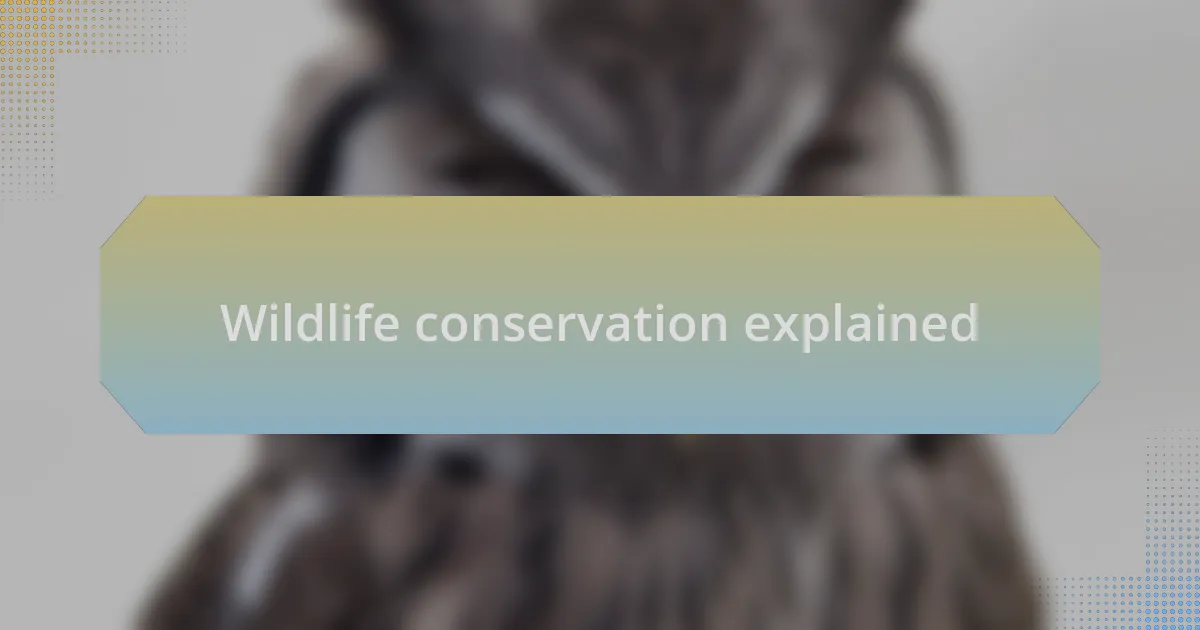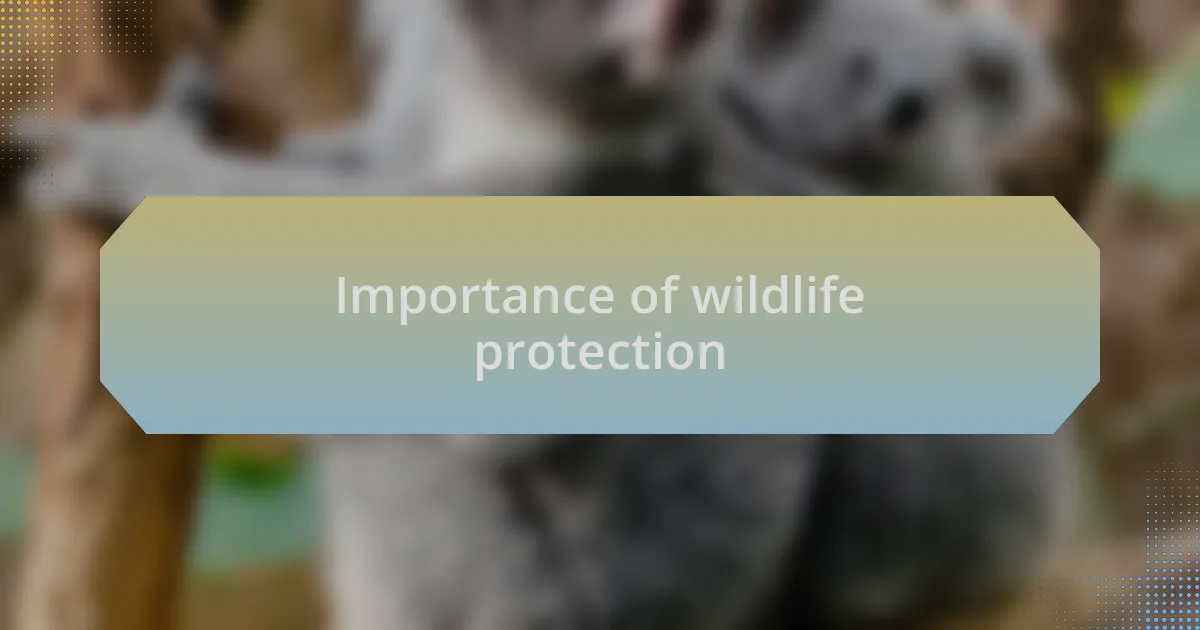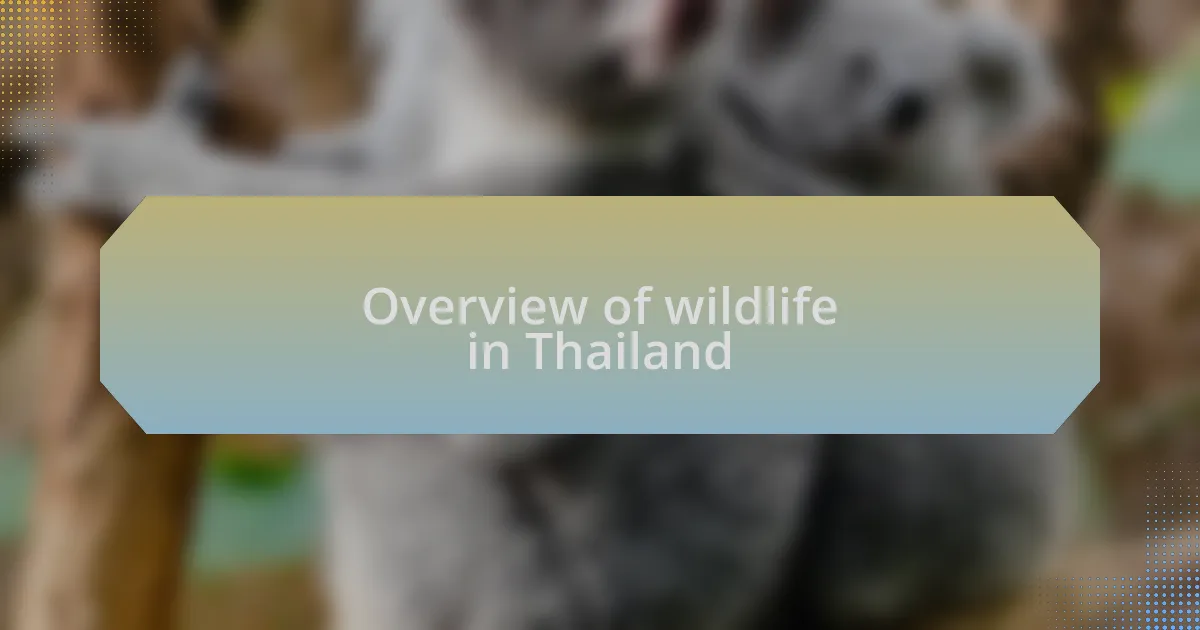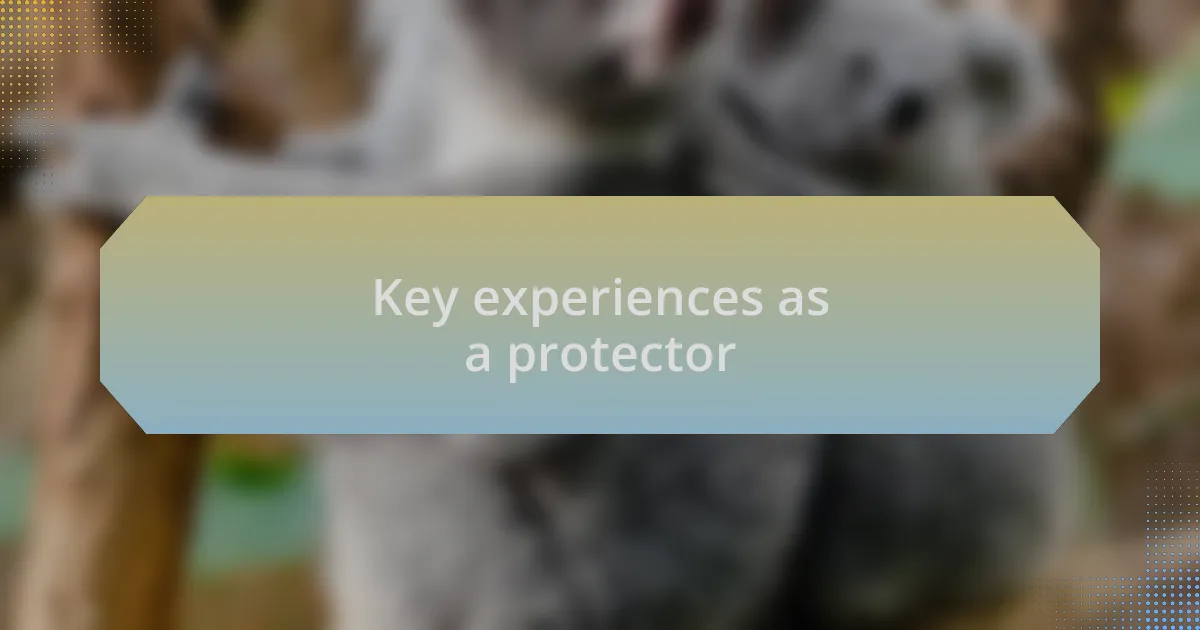Key takeaways:
- Wildlife conservation is vital for maintaining biodiversity and ecosystem health, emphasizing the interconnectedness of species and human well-being.
- Many species in Thailand face threats from habitat loss and poaching, necessitating urgent action and community involvement in conservation efforts.
- Personal experiences, such as rescuing injured animals and engaging local communities, highlight the emotional and practical challenges faced in wildlife protection.
- Successes in conservation, such as rehabilitating and releasing animals, showcase the positive impact of dedicated efforts, despite ongoing obstacles like illegal wildlife trade and habitat destruction.

Wildlife conservation explained
Wildlife conservation is the practice of protecting animal species and their habitats to ensure the health of our planet’s ecosystems. I recall standing in the lush jungles of Thailand, surrounded by vibrant creatures and plant life, realizing how interconnected everything is; when one species struggles, the ripple effect affects all of us. Have you ever thought about how our actions, like deforestation or pollution, can endanger species we may never even see?
Working in conservation teaches you that it’s not just about saving animals; it’s about preserving the delicate balance of nature. I remember a day when I encountered a wounded gibbon, its sad eyes reflecting the struggles of its species. That moment made me question—how many creatures suffer in silence because we overlook their plight? Conservation is our way of addressing these issues and fighting for a future where wildlife thrives alongside humans.
At its core, wildlife conservation empowers local communities to engage in sustainable practices beneficial for both people and wildlife. I’ve seen village leaders come together to protect the very lands that nurture their families and the wildlife that captivates their hearts. Isn’t it inspiring to think that we can create a harmonious relationship with nature, ensuring that future generations experience the same awe we do today?

Importance of wildlife protection
Wildlife protection is essential because it safeguards biodiversity, which is the foundation of healthy ecosystems. I remember hiking in a protected area of Thailand and being astonished by the variety of lifeforms around me. Can you imagine a world where such vibrant ecosystems diminish? The loss of any species can disrupt food chains and lead to unforeseen consequences that ultimately affect human well-being.
Moreover, protecting wildlife often means preserving natural habitats, which significantly contribute to climate regulation. I’ve witnessed firsthand how the deforestation of certain areas has had cascading effects on local weather patterns. It’s frightening to consider how our environment can spiral out of control when we neglect our responsibilities towards nature and the species that call it home.
Additionally, there’s a profound emotional connection we form with wildlife that transcends mere admiration. I recall the joy I felt during a sunrise watching elephants roam freely across the plains. It made me rethink: how can anyone justify harming these majestic beings? Their existence enriches our lives and teaches us about resilience and interconnectedness, reminding us of our responsibility to protect the world around us.

Overview of wildlife in Thailand
With its stunning landscapes, Thailand boasts a remarkable array of wildlife, from the dense jungles of the north to the tropical coasts in the south. I vividly remember the first time I spotted a rare gibbon swinging through the trees; it was a moment that solidified my passion for wildlife conservation. Have you ever experienced the thrill of seeing a wild animal in its natural habitat? It truly sparks a deep appreciation for these incredible creatures.
The diversity of species in Thailand is astonishing, featuring everything from majestic elephants to vibrant marine life. On one trip to Koh Tao, I snorkeled among colorful coral reefs and was amazed by the myriad of fish darting around me. Each encounter reminded me of the fragile balance that sustains these ecosystems. It’s both inspiring and alarming to think about how much is at stake as human activity encroaches on these habitats.
Sadly, many species in Thailand are threatened by habitat loss and poaching, putting immense pressure on both wildlife and biodiversity. I once participated in a rescue operation that highlighted the stark reality of conservation work: we saved a young pangolin from the illegal wildlife trade. The experience left me with an unsettling question—what can we do to change hearts and minds about protecting these vulnerable beings? It’s essential for all of us to reflect on our role in this crisis and commit to positive action.

Personal journey into conservation
When I first arrived in Thailand, I was drawn to the beauty of its landscapes and the unique wildlife that calls this country home. An unexpected encounter with a nest of baby turtles struggling to reach the sea left an indelible mark on my heart. Watching those tiny beings fight against the odds made me realize the fragility of life and ignited a spark that would guide me on my conservation journey.
In my early days as a wildlife protector, I volunteered at a sanctuary for rescued primates. One particular macaque stole my heart; she had been severely injured and abandoned. As I watched her gradually regain her strength, I couldn’t help but wonder—how many other animals were enduring similar fates? This experience opened my eyes to the urgent need for compassionate intervention and the importance of creating safe spaces for wildlife.
The journey has not been without its challenges. I vividly recall a particular campaign to raise awareness about illegal poaching, which felt overwhelming at times. I remember standing in front of a crowd, sharing stories of the animals I had encountered and the pressures they faced. I often ask myself, how can we inspire others to join this fight? By sharing our experiences, I’ve learned that collective action can be a powerful force for change in wildlife conservation.

Key experiences as a protector
One of the most impactful experiences I’ve had as a wildlife protector occurred during a rehabilitation program for injured birds. I remember carefully feeding a wounded hornbill that had been rescued from the illegal pet trade. Each time I held that little creature in my hands, I felt the weight of its past. Could it ever return to the skies? That question haunted me, yet it fueled my passion to rehabilitate and release as many birds as possible back into their natural habitat.
Another defining moment was during a community workshop focused on sustainable practices. I stood before local fishermen, sharing insights about how overfishing affects our marine ecosystems. I could see the skepticism in their eyes, but as I recounted the decline of fish populations and its ripple effect on their livelihoods, a quiet understanding began to form. Could we find a solution together? That connection has driven me to foster collaborations that bridge knowledge and tradition.
The thrill of witnessing a successful release of a rehabilitated animal is unforgettable. I distinctly recall the day we set free a rescued elephant back into the forest. The moment it took its first steps toward freedom, I felt tears of joy welling in my eyes. Was it really just the beginning for her? In that instant, I realized the importance of perseverance in conservation efforts. Each success, no matter how small, holds the potential to create a ripple effect of hope and awareness.

Challenges faced in conservation
One of the biggest challenges I faced in conservation was combatting the illegal wildlife trade. I remember a day spent dismantling traps set by poachers, my heart racing. Each trap I cut down felt like a small victory against an overwhelming foe. Yet, it struck me that for every trap I found, countless others were hidden, representing the ongoing battle to protect vulnerable species.
Another significant hurdle was tackling habitat destruction. I’ll never forget standing in a clearing, watching as bulldozers tore through lush forests. The sound was deafening, but it wasn’t just noise; it was the heartbreaking loss of homes for so many animals. How could I explain to the communities affected that preserving these ecosystems was essential not just for wildlife, but for their own future? It’s an ongoing conversation, and sometimes, I feel lost in the complexity.
Then there are the emotional tolls that come with these challenges. I often find myself feeling overwhelmed, especially when a rescued animal doesn’t survive. One sleepless night, I reflected on a young pangolin we couldn’t save. Did we do enough? Those moments of doubt can be discouraging, but rather than letting them consume me, I work to transform that grief into a driving force for change. It reminds me that each life we try to protect matters, and the fight is worth every ounce of energy I can give.